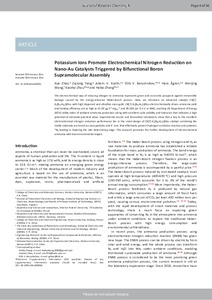Potassium ions promote electrochemical nitrogen reduction on nano-Au catalysts triggered by bifunctional boron supramolecular assembly
Скачать файл:
DOI:
10.1039/D0TA04580BURI (для ссылок/цитирований):
https://pubs.rsc.org/lv/content/articlehtml/2020/ta/d0ta04580bhttps://elib.sfu-kras.ru/handle/2311/142806
Автор:
Xue, Zhao
Ziqiong, Yang
Artem, V Kuklin
Glib, V Baryshnikov
Hans, Ågren
Wenjing, Wang
Xiaohai, Zhou
Haibo, Zhang
Коллективный автор:
Научно-исследовательская часть
Дата:
2020-07Журнал:
Journal of Materials Chemistry AКвартиль журнала в Scopus:
Q1Квартиль журнала в Web of Science:
Q1Библиографическое описание:
Xue, Zhao. Potassium ions promote electrochemical nitrogen reduction on nano-Au catalysts triggered by bifunctional boron supramolecular assembly [Текст] / Zhao Xue, Yang Ziqiong, V Kuklin Artem, V Baryshnikov Glib, Ågren Hans, Wang Wenjing, Zhou Xiaohai, Zhang Haibo // Journal of Materials Chemistry A. — 2020. — Т. 8 (№ 26). — С. 13086-13094Текст статьи не публикуется в открытом доступе в соответствии с политикой журнала.
Аннотация:
The electrochemical way of reducing nitrogen to ammonia presents green and economic advantages to dial down irreversible damage caused by the energy-intensive Haber–Bosch process. Here, we introduce an advanced catalyst CB[7]–K2[B12H12]@Au with highly dispersed and ultrafine nano-gold. The CB[7]–K2[B12H12]@Au electrochemically driven ammonia yield and Faraday efficiency is as high as 41.69 μg h−1 mgcat.−1 and 29.53% (at −0.4 V vs. RHE), respectively, reaching the US Department of Energy (DOE) utility index of ambient ammonia production along with excellent cycle stability and tolerance that indicates a high potential of industrial practical value. Experimental results and theoretical calculations show that the key to an excellent electrochemical nitrogen reduction performance lies in the smart design of the CB[7]–K2[B12H12]@Au catalyst combining the stable substrate anchored Au nanoparticles and K+ ions that effectively prevent the hydrogen evolution reaction and polarize *N2 leading to lowering of the rate determining step. This research will promote the further development of electrochemical ammonia production with low environmental impact.

